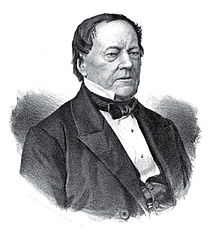Per Georg Scheutz
Per Georg Scheutz | |
|---|---|
 Portrait of Per Georg Scheutz | |
| Born | Pehr Georg Scheutz 23 September 1785 |
| Died | 22 May 1873 (aged 87) |
| Nationality | Swedish |
| Occupation(s) | Lawyer, translator, inventor |
Pehr (Per) Georg Scheutz (23 September 1785 – 22 May 1873) was a Swedish lawyer, translator, and inventor, who is now best known for his pioneering work in computer technology.
Life[edit]
Scheutz studied law at Lund University, graduating in 1805. He then worked as a legal expert and translator (he translated several works of William Shakespeare and Sir Walter Scott) before turning predominantly to liberal politics and mechanical engineering.

He is most known for his inventions; the best known of these is the Scheutzian calculation engine, invented in 1837 and finalized in 1843. This machine, which he constructed with his son Edvard Scheutz, was based on Charles Babbage's difference engine. In 1851 they obtained funds from government to build an improved model, which was created in 1853 (was roughly the size of a piano), and subsequently demonstrated at the World's Fair in Paris, 1855. The machine was then sold in 1856 to the Dudley Observatory in Albany, New York.[1][2] In 1857 British government ordered another model, which was built by Donkin's company in 1859.[3][4]
The devices were used for creating logarithmic tables.
While the machine was not perfect and could not produce complete tables, Martin Wiberg reworked the construction from the ground up and in 1875 created a compact device which would print complete tables.
Scheutz was elected a member of the Royal Swedish Academy of Sciences in 1856.
See also[edit]
References[edit]
- ^ Scheutz, George; Scheutz, Edward (1857). Specimens of Tables, Calculated, Stereomoulded, and Printed by Machinery. Whitnig. pp. Preface 8–12, 14–15, p. 3.
- ^ Merzbach, Uta C.; Zoology, Smithsonian Contributions To; Ripley, S. Dillon; Merzbach, Uta C. First Printing Calculator. pp. 8–9, 13, 25. CiteSeerX 10.1.1.639.3286.
- ^ Swade, Doron (2002-10-29). The Difference Engine: Charles Babbage and the Quest to Build the First Computer. Penguin Books. pp. 4, 207. ISBN 9780142001448.
- ^ Watson, Ian (2012-05-17). The Universal Machine: From the Dawn of Computing to Digital Consciousness. Springer Science & Business Media. pp. 37–38. ISBN 978-3-642-28102-0.
Further reading[edit]
- Michael Lingren (1990). Glory and Failure: The Difference Engines of Johann Müller, Charles Babbage and Georg and Edvard Scheutz. MIT Press. ISBN 978-0-262-12146-0.
- Mario G. Losano (ed.), Scheutz: La macchina alle differenze. Un secolo di calcolo automatico, Etas Libri, Milano 1974, pp. 164.
- Lindgren, M. (1990-12-01). "The Swedish difference engines". CWI Quarterly. 3 (4). ISSN 0922-5366.
- Archibald, Raymond Clare (1947). "P. G. Scheutz, Publicist, Author, Scientific Mechanician, and Edvard Scheutz, Engineer,—Biography and Bibliography". Mathematics of Computation. 2 (18): 238–245. doi:10.1090/S0025-5718-47-99591-4. ISSN 0025-5718.
